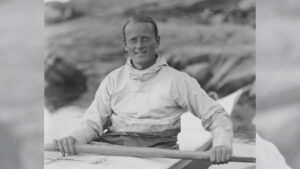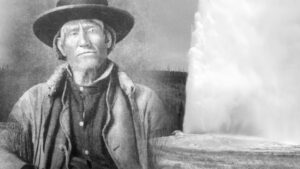Born in the Czech region of Moravia in 1868, Jan Welzl was an early master of what’s called creative nonfiction. Or perhaps he was simply a master fictionalizer in his books about the Arctic. In the most popular of those books, Thirty Years in the Golden North, he describes Inuit in the New Siberian Islands electing him their chieftain…although the New Siberia Islands never had any Inuit inhabitants. Never any year-round inhabitants at all, in fact. In another work, The Quest for Polar Treasure, he describes 36-foot tall octopi whose favorite occupation is killing unwary members of our own species.
Whether Welzl actually visited, much less explored, the places he described in his books is debatable. But there was one northern place he did visit: Dawson, which was the Yukon’s largest town at the time. Not only did he visit it, but he spent the last sixteen years of his life there. While other Dawsonites were searching for gold, Welzl occupied himself trying to create a perpetual motion machine from old beer cans and bicycle parts. To individuals who visited his cabin, he would point to the machine and, in broken English, say, “She go up, she go down, she go ‘yah, yah, yah!’”

Welzl at home in Dawson.
Welzl also regaled Dawsonites who visited his cabin with stories about his experiences in the North. For instance, he would allude to his discovery of a race of pygmy Inuit who’d arrived in Siberia on a meteor from Mars. Or he’d say that kangaroos would make better sled animals than dogs — a pity there were so few of them in the Arctic. In the end, he died not as a result of an attack by a giant octopus, but from a heart attack in 1948.
Welzl is one of the reasons why a large number of Czechs visit Dawson as tourists and sometimes end up living there. For he became an iconic figure in their Soviet-run, perhaps Soviet-ruined country in the 1950s. In their minds, he pursued the life of his choice, without any rules imposed on him by officialdom. And in passages like the following one, from Thirty Years in the Golden North, he seems to be criticizing Soviet rule of Czechoslovakia well before that rule existed: “There is true liberty up North. Nobody is limited in his freedom…Whatever you see, you can go after…there is nothing to stop you.”
The Velvet Revolution put an end to Soviet rule in the Czech Republic, but not an end to the Czech enthusiasm for Jan Welzl. In his hometown of Zabreh, the statue of Stalin was torn down, and a statue of Welzl was placed on the same pedestal that Stalin had previously occupied.

Czechs have long been making pilgrimages to Welzl’s grave in Dawson’s Catholic cemetery. When I visited the grave myself in 1992, someone had placed a boot on it, doubtless a tribute to Welzl’s wandering habit, and the cross was so laden with wreaths that it seemed in danger of toppling over. But this cross did not mark Welzl’s grave. Apparently, an early Czech visitor had gone to the cemetery in search of Welzl’s grave, and not being able to find it, he found an unmarked cross, wrote “Jan Welzl” on it, and stuck it in the ground. Welzl’s admirers were probably laying their wreaths on the grave of an itinerant Italian laborer named Peter Fagetti.
A new grave was since been determined to be Welzl’s, and it was duly consecrated on July 24, 1994. Recently, I visited this new grave with one of the Czech Dawsonites who had helped to construct it. “We created the grave out of a combination of cement and Czech beer,” he informed me, adding, with a touch of Welzlian wit, “We considered sticking a radio tube into the grave because this would make it easier for Jan to communicate with us from the Great Beyond.”
On the grave, there was now a Czech flag as well as a photo of Welzl with a very broad grin on his face. It also had a box with notebooks filled with numerous comments by Czech visitors. In the most recent notebook, I wrote the only comment in English: “May the gods of whimsy still be with you, Jan!”







